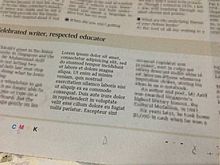Greeking
Greeking is a style of displaying or rendering text or symbols, not always from the Greek alphabet. Greeking obscures portions of a work for the purpose of either emphasizing form over details or displaying placeholders for unavailable content. The name is a reference to the phrase "Greek to me", meaning something that one cannot understand, so that it might as well be in a foreign language.
In typography

Greeked text is used in typography to evaluate a certain typeface's appropriateness, overall style or type color.[1] Because a viewer can be distracted by meaningful content, greeking unimportant text forces the viewer to focus on layout and design.
Greeking is also used when a design is being developed but the content is unfinished. One example might be the layout of a magazine article which has photographs but no text; initially, a lorem ipsum text is used, and then the nonsense text is replaced with draft versions as they become available. This allows design and layout to be carried out in parallel with content revisions.
In computing
The term "greeking" was applied by various WYSIWYG editors of the 1980s, of the type exemplified by ApplixWare and Island Graphics. Greeking referred to the literal replacement of a poorly imaged sequence of text with a literal gray bar upon moving out of focus. A busy page seen as a whole might reveal extremely a small run of ultra-fine text as greeked.
Greeking can refer to the automatic rendering of text characters as unreadable symbols or lines in the layout preview function of word processing documents, either to speed up screen display[2] or because the graphics display capabilities of the monitor are insufficient for rendering extremely small texts.[3]
In visual media
As in typography, greeking involves inserting nonsense text or, commonly, Greek or Latin text in prototypes of visual media projects (such as in graphic and web design) to check the layout of the final version before the actual text is available, or to enhance layout assessment by eliminating the distraction of readable text. Text of this sort is known as "greeked text", "dummy text", or "jabberwocky text".[2] Lorem ipsum is a commonly used example, though this is derived from Latin, not Greek.
In the arts
Greeking in theatre, television, and film production art-department work refers to the process of changing or hiding corporate trademarks that have not been "cleared" legally for use in the production.[citation needed] Anime and manga series show prolific examples of trademark greeking, creating altered versions of trademarked terms like Hescafé,[4] WcDonald's,[5] and AVIO.[6]
See also
- Lorem ipsum, for an example of one commonly used method of greeking in text.
References
- ^ Production First Software Encyclopedia of Typography and Electronic Communication : G
- ^ a b "Greeking"
- ^ Greeking, from Webopedia
- ^ "Copyright infringement? Not in Japan." Archived December 28, 2011, at the Wayback Machine
- ^ Image of Hanasaku Iroha (Ohana at WcDonald's), Anime Vice. [dead link]
- ^ "AVIO — OreImo", It's a SOMY Anime Advertisements Archived March 4, 2016, at the Wayback Machine
